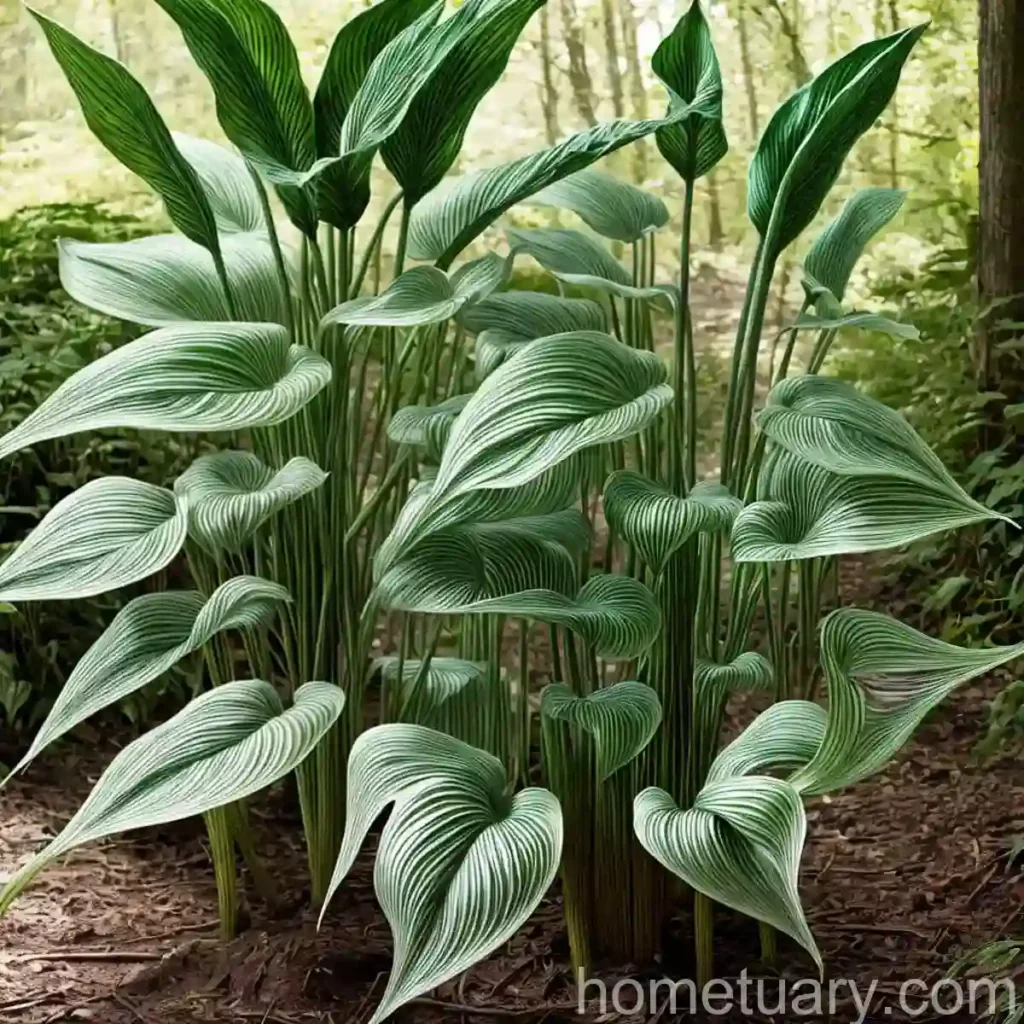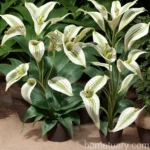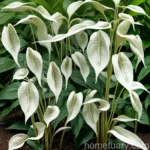All About the Jack-in-the-Pulpit (Arisaema triphyllum)
Plants have always held an allure, captivating the human imagination with their diverse forms, essential roles in ecosystems, and multifaceted uses. One such plant that has long fascinated botanists and gardeners alike is the jack-in-the-pulpit (Arisaema triphyllum). This unique and charismatic plant offers a rich tapestry of cultural significance, medicinal uses, and ecological importance.
In this comprehensive guide, we will delve into the world of jack-in-the-pulpit, exploring its botany, cultivation, uses, and much more. From the wild to the garden, this plant has left an indelible mark on the hearts and minds of those who encounter it.
What is the Jack-in-the-Pulpit (Arisaema triphyllum)?
Arisaema triphyllum, commonly known as jack-in-the-pulpit, is a herbaceous perennial plant native to the woodlands of eastern North America. It is a member of the Araceae family, a diverse group of plants that includes familiar species like the peace lily and the philodendron. Jack-in-the-pulpit is cherished for its distinctive flowering structure and its unique ability to change its sex from year to year, a phenomenon known as protogyny.
The plant derives its common name from its inflorescence, which consists of a hooded spathe, referred to as the “pulpit,” and a central spadix, known as the “jack.” The spathe is often striped or mottled with shades of green, purple, and brown, while the jack, or spadix, harbors tiny flowers.
The jack-in-the-pulpit’s blooms eventually give way to clusters of bright red berries, adding a striking pop of color to the woodland landscape. In addition to its visual appeal, this plant boasts a rich ethnobotanical history, with various indigenous communities utilizing its roots for medicinal purposes.
Key Takeaways – Jack-in-the-Pulpit (Arisaema triphyllum)
Culture
- Perennial plant native to eastern North America
- Characterized by a hooded spathe and central spadix
- Features androgynous (male and female) flowers
- Produces bright red berries after flowering
Uses
- Medicinal uses in indigenous communities
- Ornamental value in gardens and natural landscapes
- Ecological importance as a food source for wildlife
Now, let’s explore the critical factors for successfully cultivating and caring for this captivating plant.
Arisaema Triphyllum Care
Water
Jack-in-the-pulpit prefers consistently moist, well-draining soil. It thrives in areas with high humidity levels and benefits from regular watering, especially during dry spells and periods of prolonged heat. However, it’s essential to avoid waterlogged conditions, as this can lead to root rot.
Sunlight
In its natural habitat, jack-in-the-pulpit is often found in shaded woodlands, making it well-suited to partial to full shade conditions. When cultivated in gardens, providing dappled or filtered sunlight mimics its native environment and supports healthy growth and flowering.
Fertilizer
When it comes to fertilizing jack-in-the-pulpit, a light application of a balanced, organic fertilizer in early spring can provide the nutrients necessary for robust growth. However, excessive fertilization should be avoided, as this can lead to lush foliage at the expense of flowering.
Soil
As a woodland plant, jack-in-the-pulpit thrives in rich, organic soils with a slightly acidic to neutral pH. A well-amended, loamy soil that retains moisture without becoming waterlogged provides an ideal growing medium for this species.
Pruning
Minimal pruning is required for jack-in-the-pulpit. After the plant has finished flowering, removing spent blooms and any damaged or yellowing foliage can help maintain its tidiness and visual appeal.
Propagation
Jack-in-the-pulpit can be propagated by division of its corms in early spring or late summer. Planting the divided corms at the same depth as the parent plant in suitable soil conditions can ensure successful establishment.
Container Popularity
While jack-in-the-pulpit can thrive in the ground, it can also be cultivated in containers, making it a popular choice for shaded gardens, patios, and indoor settings.
Common Diseases
Like many plants, jack-in-the-pulpit is susceptible to certain diseases, including:
- Root Rot: This can occur in waterlogged or poorly drained soil conditions.
- Fungal Diseases: Various fungal pathogens can affect the plant if humidity levels are excessive.
Disease Diagnosis
Diagnosing diseases in jack-in-the-pulpit involves careful observation of the plant’s foliage, stems, and overall health. Identifying symptoms such as yellowing or wilted leaves, stunted growth, or unusual spots and lesions can help pinpoint potential disease issues.
Common Pests
Though relatively resistant to pests, jack-in-the-pulpit can occasionally fall victim to:
- Slugs and Snails: These creatures may feed on the plant’s foliage, causing damage.
- Deer: In areas with high deer populations, jack-in-the-pulpit can be a target for browsing.
Botanist’s Tips
- Plant jack-in-the-pulpit in a sheltered location with well-drained soil and partial to full shade.
- Provide consistent moisture, especially during dry spells, to support healthy growth and flowering.
- Avoid disturbing the corms excessively, as this can disrupt the plant’s growth and reproductive cycle.
Fun Facts
- The jack-in-the-pulpit plant was given its name due to its resemblance to a figure standing in a pulpit, such as a preacher or clergyman.
- Native American tribes used jack-in-the-pulpit for a variety of medicinal purposes, including as a treatment for sore throats and as a poultice for sores and bruises.
Now that we’ve covered the basics of jack-in-the-pulpit care, let’s explore some additional aspects of this captivating plant.
Arisaema Triphyllum Botanical Information
- Species: Arisaema triphyllum
- Family: Araceae
- Habitat: Woodlands and shaded, moist areas
- Native Range: Eastern North America
- Blooming Season: Late spring to early summer
- Habit: Herbaceous perennial
- Pollination: Jack-in-the-pulpit is pollinated by small insects attracted to its flowers, aiding in the production of its distinctive red berries.
How to Propagate Jack-in-the-Pulpit
Rhizome Division
Dividing the plant’s rhizomes in early spring or late summer can be an effective means of propagating jack-in-the-pulpit. When undertaking this process, care should be taken to ensure that the divided rhizomes are planted at the appropriate depth and in suitable soil conditions to encourage successful growth.
Seeds
Jack-in-the-pulpit also reproduces by seed, with its bright red berries containing multiple seeds. Collecting ripe berries and planting the seeds in well-prepared soil can yield new plants over time.
Arisaema Triphyllum Medicinal Uses
Traditional Indigenous Uses
Indigenous communities have historically utilized jack-in-the-pulpit for various medicinal applications, including:
- Sore Throat Remedy: Preparing a decoction from the plant’s roots for alleviating sore throat symptoms.
- Poultice for Sores and Bruises: Using mashed or poulticed jack-in-the-pulpit roots for external applications to soothe and heal skin abrasions.
Jack-in-the-Pulpit Habitat
In the wild, jack-in-the-pulpit is commonly found in shaded woodlands, often near streams and in moist, humus-rich soils. Its natural habitat showcases the plant’s preference for moist, well-drained conditions and partial to full shade, providing essential insights into its cultivation requirements.
Arisaema Triphyllum Native Range
Jack-in-the-pulpit is native to eastern North America, with its range extending from the Canadian provinces of Manitoba and Ontario south to Florida and west to Texas. In this diverse range of climates and ecosystems, the plant has proven adaptable, thriving in a variety of conditions within its native habitat.
Jack-in-the-Pulpit Shade Gardening
For gardeners seeking to cultivate shaded landscapes, jack-in-the-pulpit provides a valuable addition. Its preference for partial to full shade makes it an ideal choice for woodland gardens, where it can thrive alongside companion plants that share its shade-tolerant qualities.
Arisaema Triphyllum Wildflower
As a native wildflower of eastern North America, jack-in-the-pulpit contributes to the region’s rich floral diversity. Its unique appearance and ecological role as a food source for wildlife underscore its significance in native ecosystems.
Jack-in-the-Pulpit Pollination
The pollination of jack-in-the-pulpit occurs primarily through small insects attracted to its unique inflorescence. These insects facilitate the transfer of pollen between the plant’s flowers, ultimately leading to the production of its distinctive red berries.
Now, let’s delve into the ways in which jack-in-the-pulpit can be incorporated into gardens and landscapes to create beautiful and biodiverse settings.
Arisaema Triphyllum Garden Design
- Woodland Gardens: Jack-in-the-pulpit thrives in woodland garden settings, where it can be planted alongside native woodland species to create naturalistic and biodiverse landscapes.
- Shade Gardens: Due to its shade tolerance, jack-in-the-pulpit is an excellent choice for shaded garden beds and borders, imparting a sense of wild beauty to these areas.
Jack-in-the-Pulpit Foliage
The foliage of jack-in-the-pulpit is characterized by its trifoliate leaves, with three leaflets per stem. The leaves often exhibit mottled patterns and rich green hues, adding visual interest to the plant’s overall appearance.
Arisaema Triphyllum Natural Habitat
In its natural habitat, jack-in-the-pulpit thrives in moist, shaded woodlands, often near streams and in areas with rich organic soil. These natural settings offer crucial insights into the plant’s environmental requirements when cultivated in gardens and landscapes.
Jack-in-the-Pulpit Symbolism
The distinctive appearance and cultural significance of jack-in-the-pulpit have imbued it with symbolic meanings in various contexts, including:
- Spirituality: The plant’s unique inflorescence has evoked spiritual associations, likening its hooded spathe to a preacher in a pulpit, conveying themes of guidance and insight.
Arisaema Triphyllum Folklore
Jack-in-the-pulpit has been intertwined with folklore and traditional stories, with its distinctive appearance and cultural significance inspiring tales and narratives across different cultures and historical periods.
Jack-in-the-Pulpit Soil Requirements
- Moist, Well-Drained Soil: Jack-in-the-pulpit thrives in soils that retain moisture without becoming waterlogged, making well-drained, humus-rich soils ideal for its cultivation.
- Slightly Acidic to Neutral pH: A soil pH range of 6.0-7.0 provides the optimal conditions for healthy growth and development.
Arisaema Triphyllum Wildlife Value
The bright red berries of jack-in-the-pulpit are an essential food source for various wildlife species, including birds and small mammals, contributing to the plant’s ecological role in native ecosystems.
Jack-in-the-Pulpit Companion Plants
When integrating jack-in-the-pulpit into gardens and landscapes, consider companion plants that share its shade tolerance and cultural requirements, such as:
- Wild Ginger (Asarum canadense): Another native woodland species with similar shade preferences.
- Bloodroot (Sanguinaria canadensis): A spring-blooming wildflower that complements jack-in-the-pulpit in shaded settings.
Arisaema Triphyllum Gardening Tips
- Provide consistent moisture and avoid waterlogged conditions, especially during the growing season.
- Cultivate jack-in-the-pulpit in shaded locations with well-drained, humus-rich soils to mimic its natural habitat.
- Consider incorporating native woodland species as companion plants to create biodiverse and visually captivating landscapes.
Jack-in-the-Pulpit Unique Features
The jack-in-the-pulpit plant is distinguished by several unique features, including:
– Distinctive Inflorescence: The hooded spathe and central spadix give the plant its characteristic appearance, with the spathe often displaying striking patterns and colors.
– Protogynous Flowers: The ability of jack-in-the-pulpit to change its sex from year to year adds an intriguing dimension to its reproductive biology.
Arisaema Triphyllum Plant Care Guide
Planting Instructions
- Plant jack-in-the-pulpit corms at a depth of 2-4 inches in well-prepared, humus-rich soil, ensuring that they are positioned in shaded or partially shaded locations.
Summer Care
During the summer months, monitor the plant’s moisture levels and provide supplemental watering during dry spells to support its growth and development.
Winter Protection
In regions with cold winter temperatures, providing a layer of mulch over the plant’s root zone can offer protection from frost and temperature fluctuations.
Jack-in-the-Pulpit Seeds
The seeds of jack-in-the-pulpit are contained within its bright red berries, which can be collected and planted to propagate new plants. Sowing the seeds in suitable soil and maintaining consistent moisture can encourage germination and growth.
Arisaema Triphyllum Leaf Structure
The trifoliate leaf structure of jack-in-the-pulpit adds to its visual appeal, with each stem bearing three distinct leaflets. These leaves often feature mottled patterns and shades of green, contributing to the plant’s overall aesthetic charm.
Jack-in-the-Pulpit Blooming Season
Jack-in-the-pulpit typically blooms in late spring to early summer, with its distinctive inflorescence creating visual interest and appeal in garden and woodland settings.
Arisaema Triphyllum Flower Structure
The flower structure of jack-in-the-pulpit consists of a hooded spathe and central spadix, with the spathe often displaying intricate patterns and hues. The unique appearance of the inflorescence makes it a focal point in gardens and natural landscapes.
Jack-in-the-Pulpit Rhizome Propagation
Propagating jack-in-the-pulpit by rhizome division involves carefully separating the rhizomes and planting them at the appropriate depth in well-amended soil, thereby encouraging the development of new plants.
Arisaema Triphyllum Container Gardening
The shade tolerance and ornamental value of jack-in-the-pulpit make it well-suited to container gardening, providing opportunities to cultivate the plant in shaded patios, balconies, and indoor settings.
Jack-in-the-Pulpit Garden Pests
While relatively resistant to pests, jack-in-the-pulpit can face challenges from occasional pests such as slugs, snails, and deer, especially in areas with high populations of these creatures.
Arisaema Triphyllum Environmental Requirements
Jack-in-the-pulpit thrives in environments with high humidity levels, shaded or partially shaded conditions, and well-drained, humus-rich soils, reflecting its natural habitat preferences in woodland ecosystems.
Jack-in-the-Pulpit Growth Habits
The growth habits of jack-in-the-pulpit are characterized by its development of robust foliage in the spring and its subsequent flowering, followed by the production of bright red berries, contributing to its ornamental and ecological appeal.
Arisaema Triphyllum Landscape Ideas
When incorporating jack-in-the-pulpit into landscapes, consider the following ideas:
– Woodland Edge Plantings: Integrate jack-in-the-pulpit along the borders of wooded areas to create naturalistic transitions.
– Shaded Garden Beds: Cultivate the plant alongside other shade-loving species to create lush and diverse garden settings.
Jack-in-the-Pulpit Summer Care
During the summer months, monitor the plant’s moisture levels and safeguard it from excessive drought stress by providing supplemental watering as needed, particularly during prolonged periods of heat and dryness.
Arisaema Triphyllum Winter Protection
In regions with cold winter temperatures, applying a layer of organic mulch around the base of jack-in-the-pulpit can offer insulation and protection from freezing temperatures, preserving its health and vigor.
Jack-in-the-Pulpit Natural History
The natural history of jack-in-the-pulpit encompasses its ecological roles as a shade-loving woodland species, its interactions with pollinators and wildlife, and its rich legacy of traditional uses across different cultures and communities.
Arisaema Triphyllum Traditional Uses
The plant has a long history of traditional uses, with indigenous communities employing it for various medicinal applications, reflecting the deep cultural significance of jack-in-the-pulpit across generations.
Jack-in-the-Pulpit Water Requirements
Maintaining consistent moisture levels is essential for the health and vigor of jack-in-the-pulpit, with regular watering vital, particularly during dry spells and periods of heat, to support its growth and flowering.
Arisaema Triphyllum Unique Characteristics
The unique characteristics of jack-in-the-pulpit, including its distinctive inflorescence, protogynous flowering, and ethnobotanical significance, contribute to its allure and enduring appeal among botanists, gardeners, and nature enthusiasts.
Jack-in-the-Pulpit Companion Shrubs
When cultivating jack-in-the-pulpit, consider companion shrubs that share its shade tolerance and complement its ornamental attributes, such as native woodland species and shade-loving shrubs.
Arisaema Triphyllum Ethnobotany
The ethnobotanical significance of jack-in-the-pulpit is rooted in its traditional uses by indigenous communities, highlighting the plant’s multifaceted roles as a medicinal species and a cultural symbol within diverse cultural traditions.
Jack-in-the-Pulpit Plant Arrangement Ideas
When arranging jack-in-the-pulpit in gardens and landscapes, consider grouping it with native woodland species, ornamental ground covers, and shade-loving perennials to create visually striking and biodiverse settings.
Arisaema Triphyllum Garden Maintenance
Maintaining the health and vitality of jack-in-the-pulpit involves regular monitoring of moisture levels, protection from pests, and prudent pruning and care, ensuring that the plant thrives in its cultivated environment.
Jack-in-the-Pulpit Soil pH Preference
A slightly acidic to neutral soil pH ranging from 6.0-7.0 is optimal for jack-in-the-pulpit, providing the ideal conditions for nutrient uptake and overall growth and development.
Arisaema Triphyllum Garden Pests and Diseases
While relatively resilient, jack-in-the-pulpit may face challenges from pests such as slugs and snails, as well as potential diseases such as root rot and fungal pathogens, underscoring the importance of attentive care and vigilance.
Jack-in-the-Pulpit Leaf Color Variation
The leaf color of jack-in-the-pulpit can exhibit variation within the species, with some plants displaying rich green hues and others showcasing mottled patterns and unique coloration, contributing to the plant’s visual diversity and appeal.
In conclusion, the jack-in-the-pulpit (Arisaema triphyllum) stands as a captivating and charismatic species, weaving its way through the realms of culture, ecology, and horticulture. Its unique inflorescence, protogynous flowering, and traditional uses embody the rich tapestry of botanical wonders, captivating the















